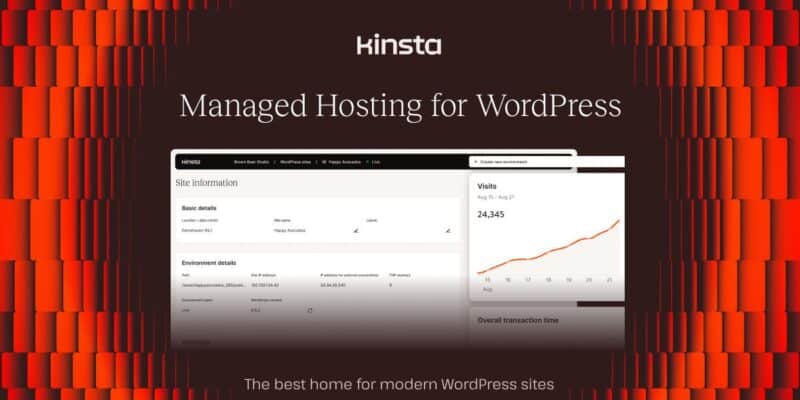Getting clients for your WordPress agency is an achievement all by itself. Once you convert them, though, it’s just as important to deliver a great experience and then retain them for the long term.
That’s where client management and client retention come into play.
Below, we’ll explain why effective client management is essential to your WordPress agency’s bottom line. Then, we’ll share 11 tips to help you deliver great experiences to your clients and improve your agency’s client retention rate.
What are client management and client retention?
Before we begin, let’s quickly define these two terms so that we’re all on the same page.
For WordPress agencies, client management refers to all of the processes and strategies you use to build and maintain relationships with your clients. These can include effective communication, project management, add-on services, and similar strategies.
Client retention for agencies is all about keeping clients engaged and satisfied over time, including maintaining a long-term work partnership and selling additional services on a one-time or recurring basis.
Why client management and retention matter
While client acquisition is one essential part of building a successful agency, client management and retention are just as important to the long-term health of your agency.
Without effective management and client retention for agencies, you’ll always be stuck on the client acquisition treadmill, and any disruption to your pipeline could quickly lead to negative effects on your agency’s financial health.
By focusing on client management and retention, you can keep your clients for longer and still have a source of revenue during periods when you’re not acquiring as many new clients as you might want.
Here are some of the main reasons to put some effort into improving your agency’s client management and retention strategies:
Keep your clients happy and satisfied
One of the primary reasons to focus on client management is to ensure your clients’ happiness and satisfaction.
While delivering a quality final product is still the most important thing to most clients, they also care about the experience along the way.
Even if the end product that you deliver meets clients’ expectations, they still might not be happy with their overall experience if your agency’s client management practices aren’t up to snuff.
Focusing on both the journey and the destination will ensure that all of your clients have a great experience with your agency.
Increase customer lifetime value by retaining more clients
Managing and retaining clients is also an essential part of boosting your agency’s bottom line.
Managing client relationships effectively will help you increase the lifetime value of each client by providing opportunities to sell retainer services and other add-ons.
These add-on services could be recurring revenue solutions, such as hosting a client’s website, or they could be additional one-off projects, like an SEO audit or conversion optimization.
If you do a good job of managing your clients, they’ll want to continue working with you on these add-on services. On the other hand, if they aren’t satisfied with how the initial project went, they’ll be more likely to seek alternative services elsewhere.
Leverage word of mouth to find new clients
Managing client relationships well doesn’t just help you retain your existing clients, it can also help you find new clients through word of mouth.
If your existing clients have a great relationship with you, they’ll be more likely to recommend you to other businesses in their networks.
Not only are these word-of-mouth referrals an effective client acquisition strategy, they also drastically reduce your customer acquisition cost because they’re essentially free.
Or, even if you do pay a referral fee, it’s still usually cheaper than other acquisition channels.
11 client management tips for agencies to boost retention
Now that you understand the benefits, let’s get into some actionable tips for how to manage client relationships and retain clients as a WordPress agency.
1. Position yourself as a long-term partner from day one
How you position your agency can play a role in winning and retaining clients right from the start.
If you position your agency as a service that provides a one-time deliverable (like a website), clients will go into your relationship expecting a one-time service.
Instead, a better approach is to position yourself as a long-term partner from the beginning. That way, clients will already expect to stay with you beyond the initial launch of their website.
For example, look at how Moove Agency positions itself as a WordPress agency “helping global brands succeed.” This type of positioning reinforces the idea that Moove Agency is a long-term partner to brands, rather than a one-time service provider.
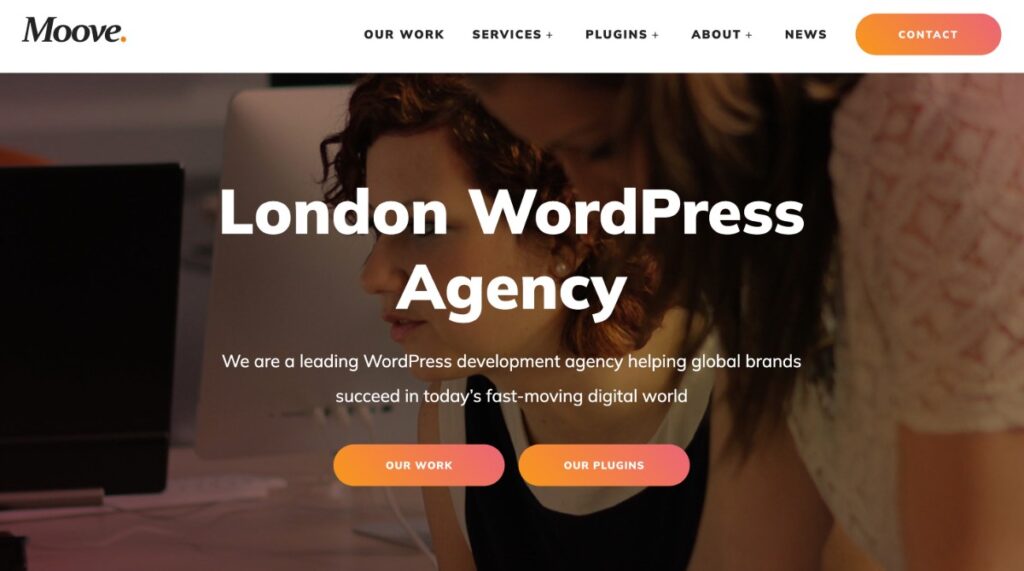
Side note: If you want to learn more about Moove Agency, we interviewed Ilona Filipi, the founder, back in 2019.
Back up this expectation with a great relationship by implementing the other client management tips in this post and you can put your agency in a position to sell additional services.
2. Set proper expectations and goals
Expectations can play a big role in how satisfied a client is, which makes setting the right expectations an important part of client management.
For example, let’s say you provide a certain deliverable in two weeks. Will a client be happy or frustrated?
- If you set expectations that the deliverable would take three weeks, the client will be happy because you’re beating their expectations.
- If you set expectations that the deliverable would take one week, the client will be frustrated because you’re not meeting expectations.
It’s the same delivery timeline in both situations, but one can lead to satisfaction and the other to frustration.
Whenever possible, you want to give yourself some buffer room to account for unexpected issues. It’s almost always better to set expectations a bit lower and over-deliver than it is to set them higher and under-deliver.
3. Be friendly and positive in client interactions
This one should probably go without saying, but it’s important to remain friendly and positive in your interactions with clients.
People like interacting with friendly people. Combining friendliness with competence is a great way to ensure a positive client relationship.
It’s also important to remember that it can be difficult to read a person’s tone over text communication. Many people have a tendency to interpret text content in the most negative way possible. Even if your intended tone is positive, any ambiguity in what you write could be interpreted in a negative way.
Spending extra time to more clearly communicate your desired tone can be worth it.
4. Provide regular updates and reports
If you want to maintain a good client relationship, it’s important to avoid a situation where your client feels they have to chase you down to figure out what’s going on with their project.
The best way to accomplish this is to provide proactive updates and reports about the progress of the project.
If you’re building a WordPress website, this could be the current status, or it could be some type of live demo website that the client can preview. You could even give them direct access to whatever project management software you’re using.
For ongoing services like WordPress maintenance or search engine optimization (SEO), it could be some type of structured report that you deliver on a specified schedule. For example, if you’re offering WordPress maintenance, the report could include data on website performance, updates, backups, and traffic.
Many SEO tools and WordPress maintenance tools include built-in features to generate reports that you can deliver to your clients.
For example, the popular Ahrefs tool offers automated SEO reports. Here’s an example from Ahrefs, powered by Looker Studio.
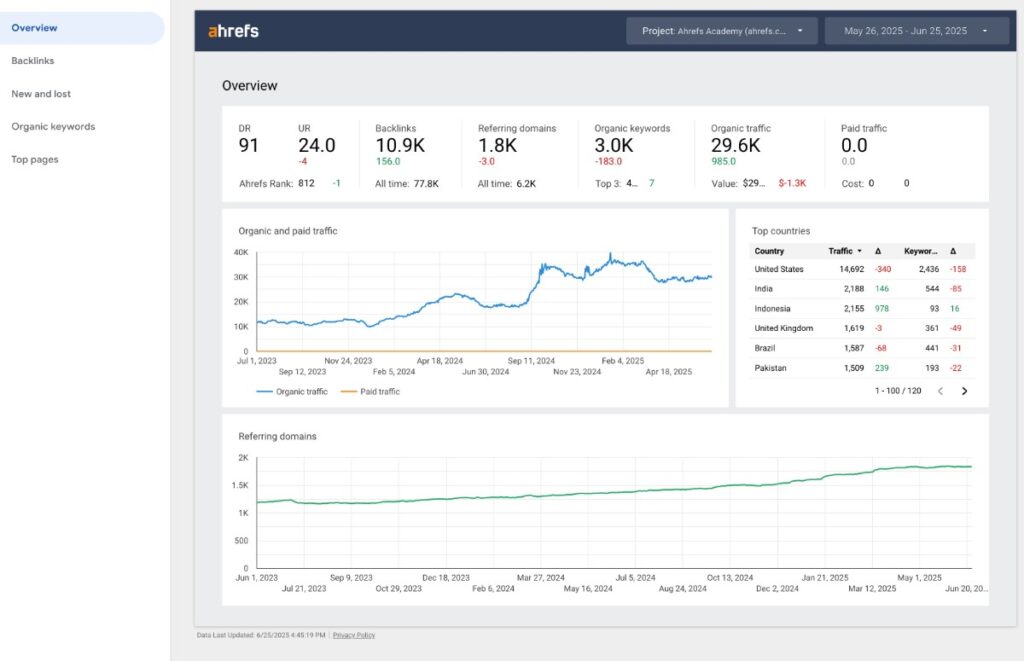
In addition to keeping the client informed, these types of reports and updates also help demonstrate the value of your agency.
If clients don’t see any progress updates or reports coming in, they might feel like you’re not really doing anything and their money is going to waste. With reports and updates, you can more tangibly demonstrate the value that you’re offering to your clients.
5. Offer high-quality retainer services
Offering quality retainer services can be one of the best ways to create more “sticky” relationships with your clients.
For a WordPress agency, one of the most fundamental services you should offer is hosting for your clients’ websites. Offering quality hosting for WordPress not only helps you build a recurring revenue stream, but it also solidifies a long-term partnership with your clients.
If you offer reliable and fast hosting for your client’s website, you’ve essentially locked them in for the long term. Usually, “lock in” has a negative connotation, but there’s nothing wrong with “locking in” your client by delivering services that always exceed their expectations.
For example, when BSharp Technology switched to Kinsta’s agency hosting for WordPress sites, they noticed that the performance improvements Kinsta helped them create stronger client relationships:
“Since moving to Kinsta, we’ve seen major improvements in performance,” says BSharp founder Matt Grill. “Clients are noticing the difference, and it’s made our relationships stronger.”
Offering quality hosting can also have a direct effect on client retention. Cosmick Media achieved a 30% increase in client retention after moving their client websites to Kinsta, while also spending 40% less time on site maintenance (which means they can spend more time on other aspects of client management).
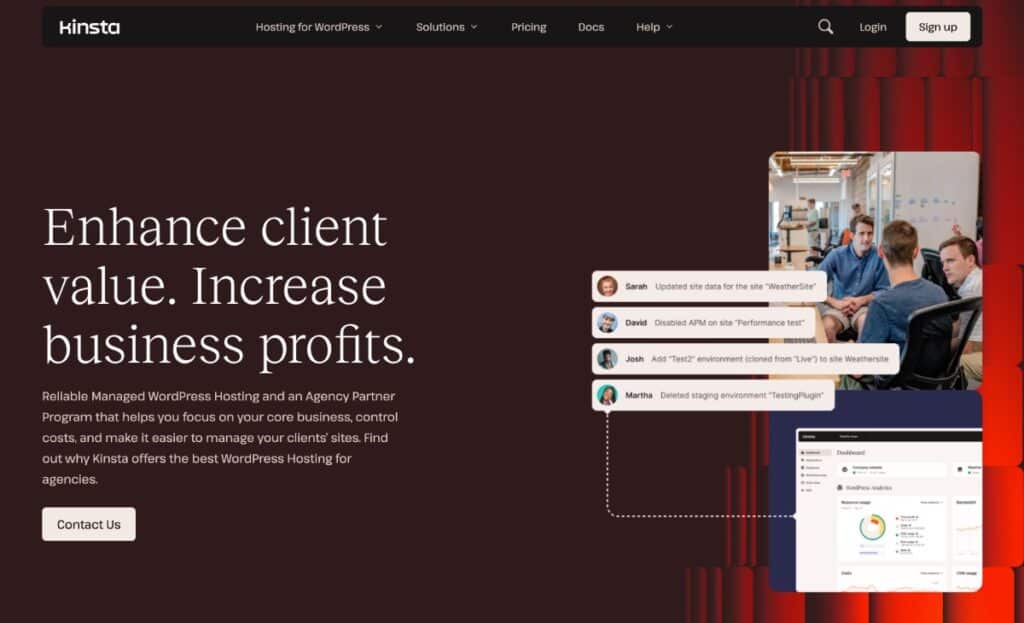
6. Structure your add-on services progressively based on client lifecycle
Building on the previous point, you can also use the way that you offer your add-on services as a tool to improve client retention. This can work because some add-on services a client doesn’t need right away might be important later in your relationship.
For example, let’s say you offer conversion rate optimization (CRO) services to your clients. Offering CRO services right after you launch a client’s website might not be the best strategy because your client lacks any baseline data and understanding of how their site performs.
Instead, you would want to offer this service in the future, after they’ve already been using their website.
Other services that can fit well in this lifecycle model include SEO, content creation, marketing automation (like setting up HubSpot or Salesforce for them), social media marketing, etc.
By timing these services in an optimal way, you can have each service build on the previous services and more easily create a long-term relationship and retain your clients.
7. Match clients’ communication preferences (when reasonable)
Every client is different when it comes to how they want to communicate during the project. Some clients might want to communicate via email, others over the phone, and others directly in whatever project management software you’re using.
When possible (and reasonable), you should try to accommodate your client’s preferences.
One of the first things to figure out is if your client prefers asynchronous communication like email or synchronous communication, like phone calls or video conferencing.
For asynchronous communication, you should consider the following questions:
- Do they prefer email, chat, or comments directly in your project management software?
- What kinds of response times do they expect?
If your client prefers synchronous communication, you should be able to answer questions like these:
- Do they prefer phone calls, video conferencing, or some other type of communication?
- What times do they prefer to communicate?
- Do they want to keep things short and sweet or get into the details and have a longer conversation? Some clients may simply want a five-minute check-in, while others may prefer a more in-depth discussion.
- How far in advance do they want to schedule things? Do they want to have a standing appointment each week or change the time based on their schedule?
- Do they use an appointment scheduling tool (like Calendly) to make it easier to schedule synchronous calls?
Of course, the “when reasonable” part is important here, as you also need to have your own boundaries. Setting up progress calls at 9 p.m. on a Saturday probably isn’t something you want to do for most clients, even if that’s their preferred time and communication method.
8. Be transparent about timelines and problems
Problems and delays are going to happen with almost every project, and often they can be outside of your control.
However, while the delay or issue might be out of your control, how you handle those problems is entirely within your control.
The best way to handle problems is to be transparent with your client. Update them as soon as possible and explain the following:
- What the problem is
- Why the problem happened
- How you’re going to fix/address the problem
- What effect the problem will have on the timeline of the project
Clients still might not be happy in some cases, but the end result will still be a lot better than trying to hide things from your clients.
9. Build a structured client onboarding process to save time later
Client onboarding can be one of the most important parts of client management because it plays a role in implementing a lot of the other tips in this post, such as setting expectations and communication preferences.
To make your onboarding as efficient as possible, create a structured process that aims to accomplish the following:
- Get your client’s goals down on paper. You’ve probably already discussed this and maybe written it into the contract, but it’s good to have these in one place so that everyone is on the same page.
- Collect needed logins and access. Getting any necessary access credentials up front will simplify client management down the road because you won’t need to ask them for help (and maybe even delay the project) every time you hit a roadblock.
- Send a client onboarding questionnaire. Your questionnaire can collect a lot of details to improve the client management process, such as a client’s preferred method of communication and availability.
- Integrate the client into your workflows. You can give the client access to your project management software and integrate them into real-time communication channels.
- Set expectations about timelines/communication. As we discussed earlier, you want to be as clear and transparent about setting these expectations upfront.
10. Proactively ask for feedback to understand how you’re doing
If you wait until a client tells you about a problem they’re having, that problem could have been simmering for a while, and it might be too late to fully address it.
To avoid having any blind spots in your customer relations, you can proactively ask clients for feedback on how you’re doing and for any ways in which you could improve.
Here are some of the questions you should be asking:
- Are you satisfied with your experience with our agency?
- Are we meeting your expectations for the project?
- How is our communication? Do you feel like we’re keeping you updated?
- Is there anything we could change to make your experience better?
- Do our business processes fit well with your business processes?
- Do you feel like we are prompt and transparent when updating you about your project?
You could ask these questions directly over email, or you could send some type of structured survey form, either via one of the many WordPress form builders and survey plugins or a SaaS survey tool.
11. Use the right tools to manage client relationships
While all of the tips above are tool-agnostic, you still need the right tools in place to effectively manage and retain your clients.
Typically, you’ll want some or all of the following tools:
- Customer relationship manager (CRM). You can find native WordPress CRM plugins. Or, you can consider SaaS CRMs like HubSpot or Clientjoy.
- Project management tool. In addition to helping your own team stay organized, a project management tool can also help you keep your clients in the loop about the progress of their projects. You could use a WordPress project management plugin or a SaaS tool like Trello or Asana or any one of the many Trello alternatives.
- Billing/invoicing. Having a smooth and simple billing process can be another important part of managing client relationships. You could use WordPress invoicing plugins or one of the many SaaS invoicing tools. Or, many agencies use their payment processor directly, such as the invoicing tools in Stripe or Square.
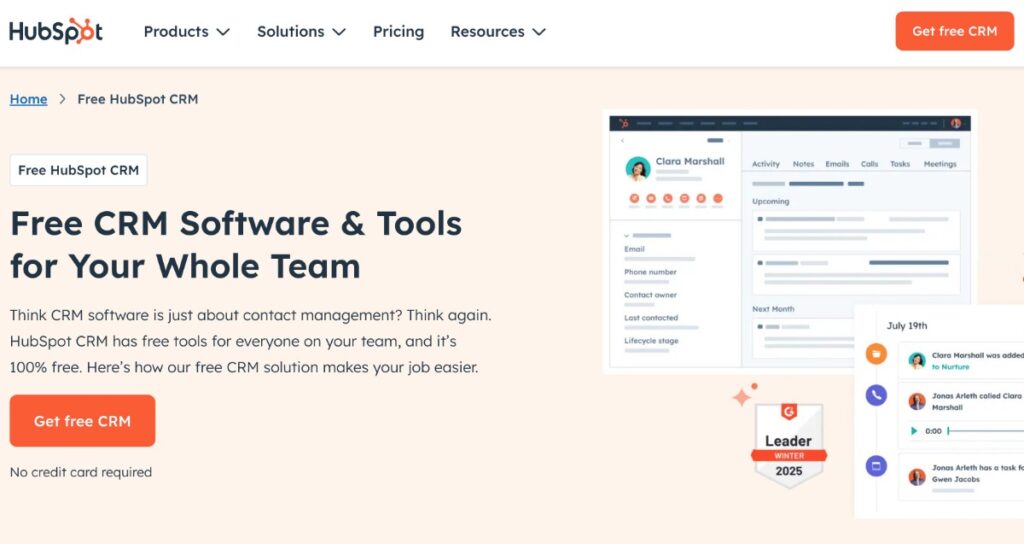
You could also consider a plugin like WP Feedback, which lets your clients provide feedback visually right on their websites. This can be a great way to involve your clients in the WordPress website design process.
Summary
While client acquisition is certainly an essential part of running a WordPress agency, client management and retention are just as important for building a successful WordPress agency.
Managing clients well and retaining them as long-term customers will give you a chance to sell additional services such as web hosting, which will boost the lifetime customer value of each client. What’s more, happy and satisfied clients will be more likely to recommend your agency to others, which can help you win valuable word-of-mouth referrals.
If you want to learn more about how Kinsta can simplify client management when it comes to offering web hosting to your clients, check out Kinsta’s WordPress hosting for agencies today.


